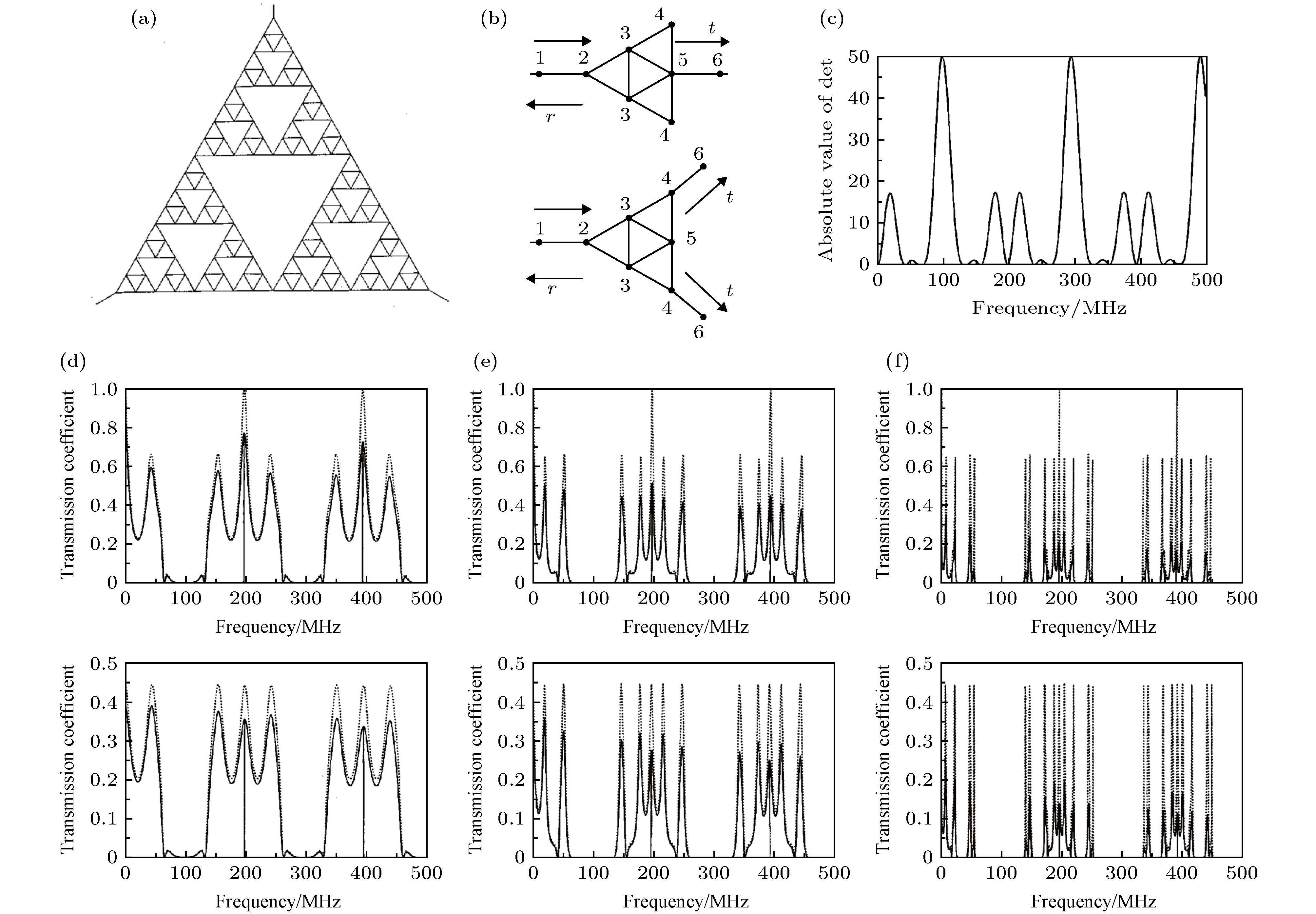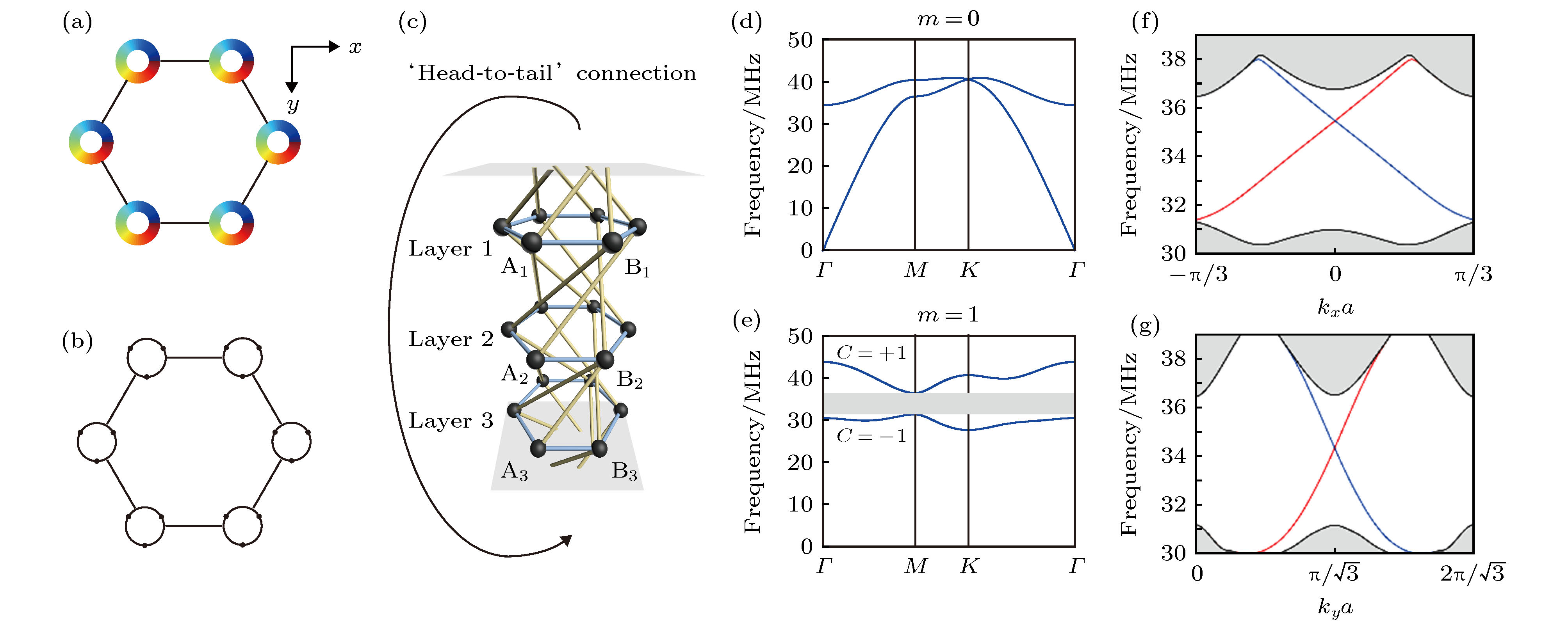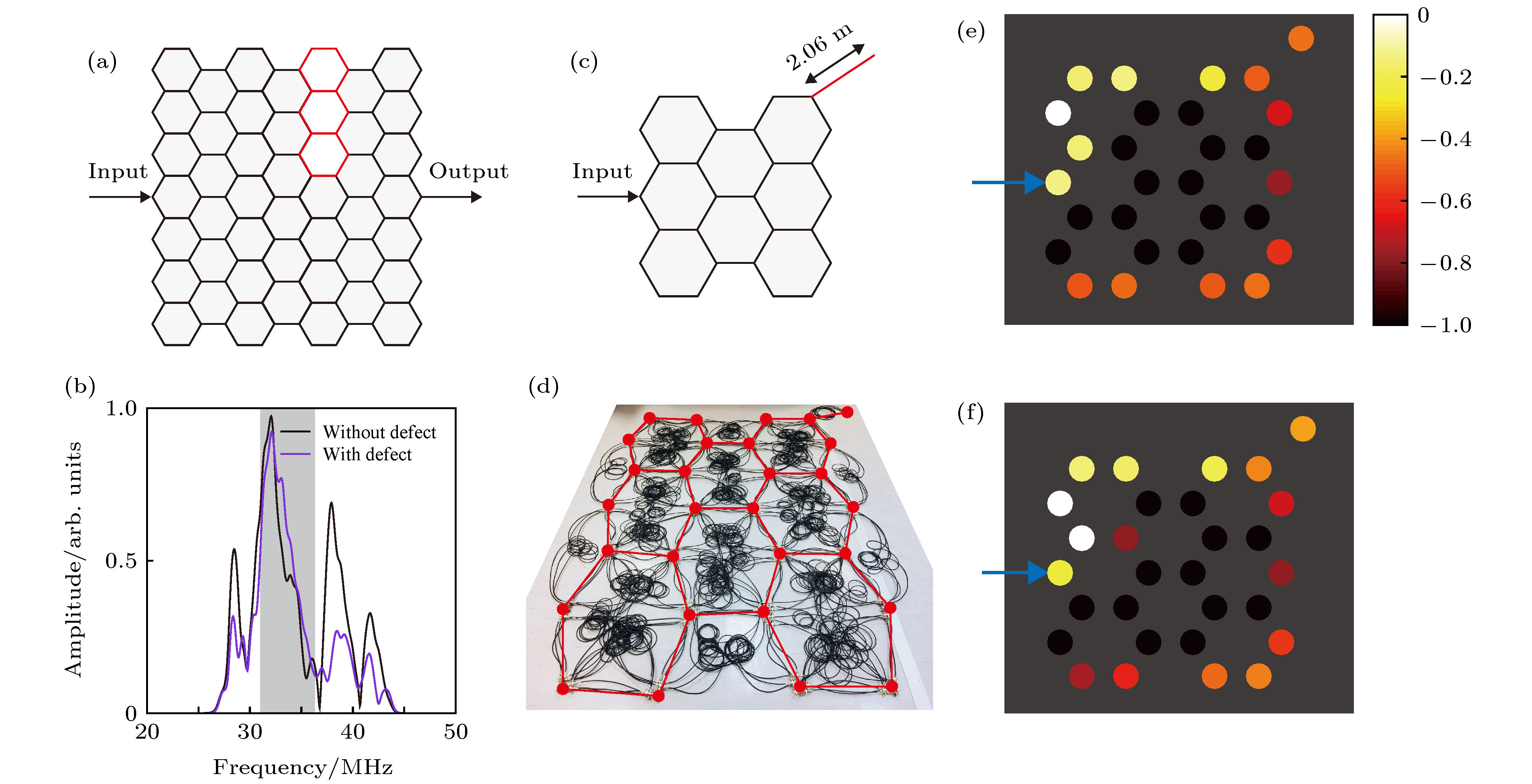-
Transmission line is a common kind of one-dimensional waveguide. In addition to being widely used in engineering, the transmission lines can be used in proof-of-principle experiments in basic scientific research. For example, the wave equations governing the transmission line and quantum wire are equivalent, so transmission lines are widely used in the research of quantum graphs. The transmission line network equations are similar to the equations of zero-energy tight binding model, so the transmission line network can also be used to study some physical properties predicted by the theories based on tight binding model, and examples include Anderson localization, band dispersions, topological properties, etc. According to the transmission line network equations, we review some applications of transmission lines in the research fields mentioned above. We will discuss Anderson localization in one-, two-, and three-dimensional networks, the band structures of periodic and quasiperiodic networks, and the angular moment-dependent topological transport in transmission line network. We introduce the methods and results in detail to show the potential of transmission lines in basic scientific research.
[1] 王宣政, 谢晓燕, 赵婧如 2005 计算机网络技术导论 (西安: 西安电子科技大学出版社) 第24页
Wang X Z, Xie X Y, Zhao J R 2005 Introduction of Computer Network Technology (Xi’an: Xidian University Press) p24 (in Chinese)
[2] Hul O, Bauch S, Pakoński P, Savytskyy N, Życzkowski K, Sirko L 2004 Phys. Rev. E 69 056205
 Google Scholar
Google Scholar
[3] Joyner C H, Müller S, Sieber M 2014 Europhys. Lett. 107 50004
 Google Scholar
Google Scholar
[4] Rehemanjiang A, Allgaier M, Joyner C H, Müller S, Sieber M, Kuhl U, Stöckmann H J 2016 Phys. Rev. Lett. 117 064101
 Google Scholar
Google Scholar
[5] Dietz B, Yunko V, Białous M, Bauch S, Ławniczak M, Sirko L 2017 Phys. Rev. E 95 052202
 Google Scholar
Google Scholar
[6] Ławniczak M, Białous M, Yunko V, Bauch S, Sirko L 2018 Phys. Rev. E 98 012206
 Google Scholar
Google Scholar
[7] Białous M, Dietz B, Sirko L 2019 Phys. Rev. E 100 012210
 Google Scholar
Google Scholar
[8] Ławniczak M, Lipovský J, Sirko L 2019 Phys. Rev. Lett. 122 140503
 Google Scholar
Google Scholar
[9] Zhang Z Q, Sheng P 1994 Phys. Rev. B 49 83
 Google Scholar
Google Scholar
[10] Zhang Z Q, Wong C C, Fung K K, Ho Y L, Chan W L, Kan S C, Chan T L, Cheung N 1998 Phys. Rev. Lett. 81 5540
 Google Scholar
Google Scholar
[11] Li M, Liu Y, Zhang Z Q 2000 Phys. Rev. B 61 16193
 Google Scholar
Google Scholar
[12] Cheung S K, Chan T L, Zhang Z Q, Chan C T 2004 Phys. Rev. B 70 125104
 Google Scholar
Google Scholar
[13] Sengupta S, Chakrabarti A 2005 Phys. Lett. A 341 221
 Google Scholar
Google Scholar
[14] Pal B, Patra P, Saha J P, Chakrabarti A 2013 Phys. Rev. A 87 023814
 Google Scholar
Google Scholar
[15] Nandy A, Chakrabarti A 2016 Phys. Rev. A 93 013807
 Google Scholar
Google Scholar
[16] Jiang T, Xiao M, Chen W J, Yang L, Fang Y, Tam W Y, Chan C T 2019 Nat. Commun. 10 434
 Google Scholar
Google Scholar
[17] Nandy A, Mukherjee A 2019 Phys. Lett. A 383 2318
 Google Scholar
Google Scholar
[18] Wang Z Y, Yang X 2007 Phys. Rev. B 76 235104
 Google Scholar
Google Scholar
[19] Xiao Q, Yang X, Lu J, Liu C 2012 Opt. Commun. 285 3775
 Google Scholar
Google Scholar
[20] Zhi Y, Yang X, Wu J, Du S, Cao P, Deng D, Liu C T 2018 Photonics Research 6 579
 Google Scholar
Google Scholar
[21] Wu H, Yang X, Tang Y, Tang X, Deng D, Liu H, Wei Z 2019 Ann. Phys. 531 1900120
 Google Scholar
Google Scholar
[22] Wu H, Yang X, Deng D, Liu H 2019 Phys. Rev. A 100 033832
 Google Scholar
Google Scholar
[23] Wu J 2019 Phys. Lett. A 383 125915
 Google Scholar
Google Scholar
[24] Alexander S 1983 Phys. Rev. B 27 1541
 Google Scholar
Google Scholar
[25] MacKinnon A, Kramer B 1981 Phys. Rev. Lett. 47 1546
 Google Scholar
Google Scholar
[26] McCall S L, Platzman P M, Dalichaouch R, Smith D, Schultz S 1991 Phys. Rev. Lett. 67 2017
 Google Scholar
Google Scholar
[27] Dalichaouch R, Armstrong J P, Schultz S, Platzman P M, McCall S L 1991 Nature 354 53
 Google Scholar
Google Scholar
[28] Conversano E, Lalli L T 2011 J. Appl. Math 4 114
[29] Mitchell N P, Nash L M, Hexner D, Turner A M, Irvine W T 2018 Nat. Phys. 14 380
 Google Scholar
Google Scholar
[30] Kitaev A 2006 Ann. Phys. 321 2
 Google Scholar
Google Scholar
-
图 1 传输线网络中透反射谱和能带的计算 (a) 有输入输出的开放性传输线网络; (b) 一维的周期性传输线网络; (c) 二维的周期性传输线网络; (d) 三维的周期性传输线网络; (e)−(g) 分别对应(b)−(d)中三种网络的能带图
Figure 1. Transmission/reflection spectra and band structures in transmission line network: (a) The transmission line network with input and output (open boundary); (b) one-dimensional (1D) periodic transmission line network; (c) two-dimensional (2D) periodic transmission line network; (d) three-dimensional (3D) periodic transmission line network; (e)−(g) correspond to the band structures of the networks shown in (b)−(d) respectively.
图 2 一维和二维传输线网络中安德森局域化的研究[9] (a) 一维的随机传输线网络, 通过配位数和电缆长度的变化来引入随机性; (b) 二维的随机传输线网络, 通过在正方格子网络中随机移除结点之间的电缆来引入随机性
Figure 2. Anderson localization in 1D and 2D transmission line networks[9]: (a) 1D random transmission line network, the randomness is introduced by changing the coordination numbers and cable lengths; (b) 2D random transmission line network, the randomness is introduced by removing the cables randomly in the square lattice network.
图 3 在三维传输线网络中实验观测安德森局域态[10] (a) 样品结构示意图, 样品为AB层交替堆叠的结构; (b) 左图为(a)所示的样品测量得到的透射频谱, 圆点虚线和实线分别为实验测量和模拟结果; 右图为引入缺陷后得到的透射频谱, 圆点虚线和实线分别为实验和模拟结果, 细虚线为不考虑传输线损耗的模拟结果; (c) 引入随机性后的透射频谱, 圆点虚线和实线分别为实验和模拟结果, 细虚线为不考虑损耗的模拟结果; (d) 在不同的样品尺寸下计算IPR来评测态的延展程度; (e) 当频率为46.66 MHz时的散射波函数强度场图; (f), (g) 分别为实验测量和模拟得到的安德森局域态的强度场图, (g)图中还给出了该随机样品的电缆连接情况
Figure 3. Experimental observation of Anderson localization in 3D transmission line network[10]: (a) The structure of the sample (it is the AB alternatively stacked structure); (b) the left panel is the transmission spectrum measured for the sample in (a), the circles and solid curves are the measured and calculated results respectively; the right panel is the transmission spectrum after introducing a defect, the circles and solid curves are the measured and calculated results respectively, the dotted curve is the calculated result without dissipation; (c) the transmission spectrum after introducing randomness, where the circles and solid curves are the measured and calculated results, and the dotted curve is the calculated result without considering dissipation; (d) inverse participation ratios (IPRs) for different sample scales; (e) the field intensity pattern of the scattered wave function at 46.66 MHz; (f) and (g) are measured and calculated field intensity pattern of localized states respectively, (g) also shows the connections of the random network sample.
图 4 Sierpinski分形传输线网络的透射谱和能带结构[11] (a) 四阶Sierpinski网络, 三个顶点连着输入输出线; (b) 有输入输出的一阶Sierpinski网络, 上图对应单输出, 下图对应双输出; (c) 求解封闭一阶Sierpinski网络的本征频率, 纵坐标为矩阵M的行列式绝对值, 横坐标为频率, 当行列式绝对值为零时, 对应着网络的本征频率; (d)—(f) 分别对应一阶、二阶、三阶Sierpinski网络的透射频谱, 上排的图对应单输出的情况, 下排的图对应双输出
Figure 4. Transmission spectra and band structures of Sierpinski fractal transmission line networks[11]: (a) A 4th-generation Sierpinski network with three input/output cables on its three vertices; (b) the 1st-generation Sierpinski network with input/output cables, the upper panel corresponds to the single-exist case while the lower one to the double-exist case; (c) the eigen-frequencies of an isolated first-generation Sierpinski network, the vertical axis corresponds to the absolute value of the determinant of matrix M, the horizontal axis corresponds to frequency. When the absolute value of determinant equals to zero, the corresponding frequency is an eigen-frequency; (d)−(f) correspond to the transmission spectra of the 1st, 2nd, 3rd Sierpinski networks respectively, the upper rows correspond to the single exit channel case and the lower rows correspond to the double exit channel case.
图 5 不同基础构造单元对周期性及准周期性网络的能带带隙的影响[12] (a) 三角形(实线)、正方形(细虚线)、六边形(粗虚线)单环网络的透射频谱; (b) 正方形晶格网络的能带(左图)和透射频谱(右图); (c) 和(b)一样, 但是在(b)的方格网络中的对角线位置加入传输线(见右下角插图)
Figure 5. Influence of the fundamental loop on the band gaps of the periodic and quasiperiodic networks[12]: (a) The transmission spectra of the triangle (solid curve), square (dotted curve), hexagon (dash curve) loop networks; (b) the band structure (left panel) and the transmission spectrum (right panel) of the square lattice; (c) the same as (b), but for the lattice network which add cables on the diagonals of the square lattice (see the inset at the right lower corner).
图 6 具有拓扑性质的传输线网络[16] (a) 由具有轨道角动量涡旋的元原子构成六角蜂巢晶格结构; (b) 将(a)中的元原子离散化为三个节点; (c) 在(b)的基础上引入轨道角动量和波矢之间的耦合, 这里只画出了晶格中的一个六边形; (d), (e) 计算(c)所示的传输线网络能带, 分别对应m = 0和m = 1; (f), (g)分别是m = 1情况下沿着x和y方向的投影能带, 红色和蓝色分别代表位于两个相对边界的边界态
Figure 6. Transmission line network possessing topological properties[16]: (a) A hexagonal ring formed by the meta-atoms which possess angular momentum; (b) discretizing the meta-atom into three nodes; (c) shows how to introduce the coupling between the angular momentum and wave vector to the model in (b). Here we only show a hexagon of the honeycomb lattice; (d), (e) calculated band structures of the model in (c) for the m = 0 and m = 1 sectors respectively; (f), (g) projected band structures along x and y directions for m = 1 modes, the red and blue curves represent the edge states at the opposite boundaries respectively.
图 7 拓扑边界态的鲁棒性和实验观测拓扑边界态[16] (a) 用来模拟测试边界态鲁棒性的样品示意图; (b) 对(a)中的样品进行模拟得到的m = 1透射频谱(紫线), 并且和没有缺陷的同尺寸样品(黑线)进行对比; (c) 用来实验观测边界态的样品示意图; (d) 实验样品的照片, 红点和红线标出了样品的大致框架; (e), (f) 分别是实验和模拟得到的m = 1边界态场图, 频率为34.5 MHz
Figure 7. Robustness of topological edge states and its experimental observation[16]: (a) The sample configuration to verify the robustness of edge states in simulations; (b) the simulated transmission spectrum of m = 1 modes (purple curve) for the sample in (a), compared with the one without defect (black curve); (c) the experimental configuration used to observe the edge states; (d) the photo of experimental sample, red dots and lines are used to highlight its underlying honeycomb structure; (e), (f) the experimental and simulated field intensity patterns of the edge state for m = 1 modes at 34.5 MHz.
图 8 有限样品中局域陈数的计算[16] (a) 计算局域陈数的方法; (b) 从左至右分别为能级图、局域陈数和截止频率的关系、局域陈数场图, 研究的样品尺寸如右图所示; (c) 和(b)图相同, 但所计算的样品尺寸和实验样品尺寸相同
Figure 8. Calculation of local Chern number in the finite samples[16]: (a) The computation domain for local Chern number calculations; (b) from left to right: energy level, the relation between local Chern number and cutoff frequency, local Chern number patterns. The size of sample can be seen in the right panel; (c) the same as (b), but the sample size equals to the size in experiments.
-
[1] 王宣政, 谢晓燕, 赵婧如 2005 计算机网络技术导论 (西安: 西安电子科技大学出版社) 第24页
Wang X Z, Xie X Y, Zhao J R 2005 Introduction of Computer Network Technology (Xi’an: Xidian University Press) p24 (in Chinese)
[2] Hul O, Bauch S, Pakoński P, Savytskyy N, Życzkowski K, Sirko L 2004 Phys. Rev. E 69 056205
 Google Scholar
Google Scholar
[3] Joyner C H, Müller S, Sieber M 2014 Europhys. Lett. 107 50004
 Google Scholar
Google Scholar
[4] Rehemanjiang A, Allgaier M, Joyner C H, Müller S, Sieber M, Kuhl U, Stöckmann H J 2016 Phys. Rev. Lett. 117 064101
 Google Scholar
Google Scholar
[5] Dietz B, Yunko V, Białous M, Bauch S, Ławniczak M, Sirko L 2017 Phys. Rev. E 95 052202
 Google Scholar
Google Scholar
[6] Ławniczak M, Białous M, Yunko V, Bauch S, Sirko L 2018 Phys. Rev. E 98 012206
 Google Scholar
Google Scholar
[7] Białous M, Dietz B, Sirko L 2019 Phys. Rev. E 100 012210
 Google Scholar
Google Scholar
[8] Ławniczak M, Lipovský J, Sirko L 2019 Phys. Rev. Lett. 122 140503
 Google Scholar
Google Scholar
[9] Zhang Z Q, Sheng P 1994 Phys. Rev. B 49 83
 Google Scholar
Google Scholar
[10] Zhang Z Q, Wong C C, Fung K K, Ho Y L, Chan W L, Kan S C, Chan T L, Cheung N 1998 Phys. Rev. Lett. 81 5540
 Google Scholar
Google Scholar
[11] Li M, Liu Y, Zhang Z Q 2000 Phys. Rev. B 61 16193
 Google Scholar
Google Scholar
[12] Cheung S K, Chan T L, Zhang Z Q, Chan C T 2004 Phys. Rev. B 70 125104
 Google Scholar
Google Scholar
[13] Sengupta S, Chakrabarti A 2005 Phys. Lett. A 341 221
 Google Scholar
Google Scholar
[14] Pal B, Patra P, Saha J P, Chakrabarti A 2013 Phys. Rev. A 87 023814
 Google Scholar
Google Scholar
[15] Nandy A, Chakrabarti A 2016 Phys. Rev. A 93 013807
 Google Scholar
Google Scholar
[16] Jiang T, Xiao M, Chen W J, Yang L, Fang Y, Tam W Y, Chan C T 2019 Nat. Commun. 10 434
 Google Scholar
Google Scholar
[17] Nandy A, Mukherjee A 2019 Phys. Lett. A 383 2318
 Google Scholar
Google Scholar
[18] Wang Z Y, Yang X 2007 Phys. Rev. B 76 235104
 Google Scholar
Google Scholar
[19] Xiao Q, Yang X, Lu J, Liu C 2012 Opt. Commun. 285 3775
 Google Scholar
Google Scholar
[20] Zhi Y, Yang X, Wu J, Du S, Cao P, Deng D, Liu C T 2018 Photonics Research 6 579
 Google Scholar
Google Scholar
[21] Wu H, Yang X, Tang Y, Tang X, Deng D, Liu H, Wei Z 2019 Ann. Phys. 531 1900120
 Google Scholar
Google Scholar
[22] Wu H, Yang X, Deng D, Liu H 2019 Phys. Rev. A 100 033832
 Google Scholar
Google Scholar
[23] Wu J 2019 Phys. Lett. A 383 125915
 Google Scholar
Google Scholar
[24] Alexander S 1983 Phys. Rev. B 27 1541
 Google Scholar
Google Scholar
[25] MacKinnon A, Kramer B 1981 Phys. Rev. Lett. 47 1546
 Google Scholar
Google Scholar
[26] McCall S L, Platzman P M, Dalichaouch R, Smith D, Schultz S 1991 Phys. Rev. Lett. 67 2017
 Google Scholar
Google Scholar
[27] Dalichaouch R, Armstrong J P, Schultz S, Platzman P M, McCall S L 1991 Nature 354 53
 Google Scholar
Google Scholar
[28] Conversano E, Lalli L T 2011 J. Appl. Math 4 114
[29] Mitchell N P, Nash L M, Hexner D, Turner A M, Irvine W T 2018 Nat. Phys. 14 380
 Google Scholar
Google Scholar
[30] Kitaev A 2006 Ann. Phys. 321 2
 Google Scholar
Google Scholar
Catalog
Metrics
- Abstract views: 10589
- PDF Downloads: 382
- Cited By: 0















 DownLoad:
DownLoad:







